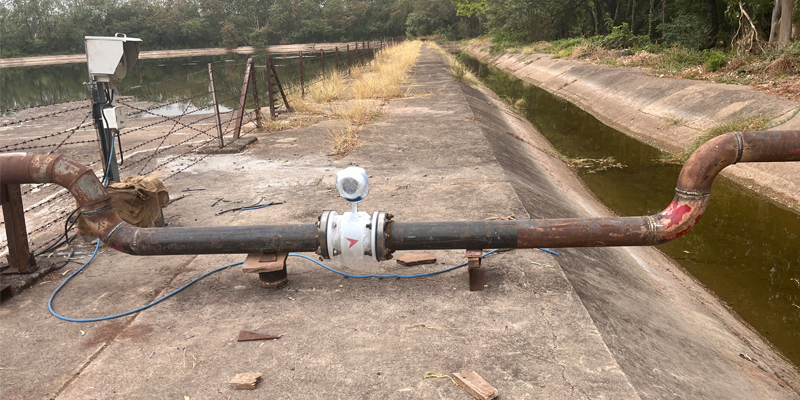
Introduction
Effluent Treatment Plants (ETP) and Sewage Treatment Plants (STP) play a crucial role in treating industrial effluents and sewage to prevent environmental pollution. Accurate flow measurement is vital for efficient operation and compliance with environmental regulations. Electromagnetic flow meters are commonly used in ETP and STP plants due to their accuracy, reliability, and suitability for various types of fluids.
How Electromagnetic Flow Meters Work
Electromagnetic flow meters, also known as mag meters, operate based on Faraday’s Law of Electromagnetic Induction. According to this law, a voltage is induced when a conductive fluid flows through a magnetic field. The induced voltage is directly proportional to the flow velocity of the fluid.
Key components of a mag meter include:
- Electrodes: Placed in the pipe walls, these detect the induced voltage.
- Magnetic Coils: Generate the magnetic field perpendicular to the flow direction.
- Flow Tube: The pipe section where the measurement takes place, often lined with a non-conductive material to isolate the electrodes from the pipe.
Benefits of Electromagnetic Flow Meters in ETP/STP Plants
- Accuracy: Electromagnetic flow meters provide high accuracy, typically within ±0.5% of the actual flow rate. This is essential for monitoring and controlling the flow of wastewater and treated effluent.
- No Moving Parts: The absence of moving parts reduces maintenance requirements and enhances reliability.
- Wide Range of Applications: Suitable for various fluid types, including slurries, sewage, and corrosive fluids.
- Bidirectional Flow Measurement: Can measure flow in both directions, useful in complex piping systems.
- Minimal Pressure Drop: The design ensures that the flow meter does not significantly impede fluid flow, maintaining process efficiency.
Applications in ETP/STP Plants
- Influent and Effluent Flow Measurement: Accurate measurement of incoming and outgoing wastewater ensures proper treatment and regulatory compliance.
- Chemical Dosing: Precise flow measurement is crucial for the accurate dosing of chemicals used in the treatment process.
- Sludge Handling: Mag meters can handle the measurement of sludge flow, aiding in effective sludge management and disposal.
Installation and Maintenance Tips
- Proper Grounding: Ensure the flow meter and the piping system are properly grounded to avoid electrical interference.
- Full Pipe Condition: The pipe must be full for accurate measurement. Avoid installation at high points in the piping system where air pockets may form.
- Straight Pipe Lengths: Install the flow meter with sufficient straight pipe lengths upstream and downstream to ensure stable flow profiles. Typically, 5-10 pipe diameters upstream and 3-5 downstream are recommended.
- Regular Calibration: Periodic calibration ensures sustained accuracy and reliability of the flow meter.
Advanced Technical Aspects of Electromagnetic Flow Meters
1. Construction and Materials
Electromagnetic flow meters are constructed with materials that ensure durability and compatibility with different types of wastewater. Key construction features include:
- Lining Material: Common lining materials include PTFE, PFA, and rubber, chosen based on the chemical properties of the fluid.
- Electrode Material: Electrodes are made from materials like stainless steel, Hastelloy, and titanium, which are resistant to corrosion and abrasion.
- Housing: The outer housing is typically made of stainless steel or other robust materials to withstand harsh environmental conditions.
2. Signal Processing
Modern electromagnetic flow meters are equipped with advanced signal processing capabilities to enhance accuracy and reliability. These include:
- Noise Reduction: Techniques such as digital filtering and signal averaging reduce electrical noise and ensure stable readings.
- Auto Zero Function: Automatically compensates for zero-point drift caused by changes in fluid conductivity or temperature.
- Diagnostic Functions: Self-diagnostic features monitor the health of the flow meter, alerting operators to potential issues such as electrode fouling or magnetic coil failures.
3. Communication and Integration
Electromagnetic flow meters can be integrated into plant control systems through various communication protocols, enabling real-time monitoring and control. Common communication options include:
- 4-20mA Output: Analog signal output for interfacing with traditional control systems.
- HART Protocol: Allows two-way communication for configuration and diagnostics over the 4-20mA signal.
- Modbus, Profibus, and Fieldbus: Digital communication protocols for seamless integration with SCADA systems and plant automation networks.
Advanced Applications in ETP/STP Plants
1. Real-Time Monitoring and Data Analysis
Electromagnetic flow meters can be part of an integrated monitoring system that provides real-time data on flow rates, helping operators optimize treatment processes. Benefits include:
- Flow Balancing: Ensures even distribution of wastewater to various treatment units, improving overall efficiency.
- Leak Detection: Identifies leaks or unauthorized discharges by detecting discrepancies between expected and actual flow rates.
- Performance Monitoring: Tracks the performance of pumps, valves, and other equipment, facilitating predictive maintenance.
2. Energy Management
Efficient flow measurement contributes to energy savings in ETP/STP plants by optimizing the operation of pumps and other equipment. For example:
- Variable Frequency Drives (VFDs): Flow meters provide feedback to VFDs, adjusting pump speeds to match the required flow rates and reducing energy consumption.
- Pump Efficiency: Monitoring flow and pressure data helps in maintaining pumps at their optimal efficiency points.
3. Compliance and Reporting
Regulatory agencies require accurate flow measurement and reporting to ensure compliance with environmental standards. Electromagnetic flow meters facilitate:
- Accurate Reporting: Precise flow data ensures accurate reporting of treated effluent volumes.
- Compliance Verification: Flow meters help verify compliance with discharge permits and regulatory limits, avoiding fines and penalties.
- Audit Trails: Digital data logging provides an audit trail for regulatory inspections and reviews.
Case Studies
Case Study 1: Industrial ETP with High Solids Content
An industrial effluent treatment plant dealing with high solids content and aggressive chemicals implemented electromagnetic flow meters for influent and effluent measurement. The chosen mag meters featured:
- High Abrasion Resistance: Robust lining and electrode materials suitable for slurry applications.
- Enhanced Signal Processing: Advanced filtering techniques to manage signal noise caused by suspended solids.
- Remote Monitoring: Integration with a SCADA system for real-time monitoring and control.
Outcome: Improved accuracy in flow measurement, reduced maintenance costs, and better compliance with discharge regulations.
Case Study 2: Municipal STP with Variable Flow Rates
A municipal sewage treatment plant facing variable flow rates due to fluctuating population demands installed electromagnetic flow meters to manage influent and effluent flows. Key features included:
- Wide Rangeability: Capable of measuring low to high flow rates with consistent accuracy.
- Bidirectional Measurement: Enabled precise flow measurement in both directions during pumping and backflow scenarios.
- Energy Optimization: Feedback to VFDs optimized pump operation, reducing energy consumption.
Outcome: Enhanced operational efficiency, lower energy costs, and reliable compliance with environmental regulations.
Future Trends
1. IoT and Smart Flow Meters
The integration of IoT (Internet of Things) technology in flow meters is revolutionizing the way ETP/STP plants operate. Smart flow meters equipped with IoT capabilities offer:
- Remote Diagnostics: Real-time health monitoring and diagnostics, reducing downtime and maintenance costs.
- Predictive Maintenance: Data analytics and machine learning predict potential failures before they occur, enabling proactive maintenance.
- Cloud Connectivity: Flow data is stored in the cloud, providing easy access for analysis and reporting.
2. Sustainability and Circular Economy
Electromagnetic flow meters are contributing to the sustainability goals of ETP/STP plants by:
- Resource Optimization: Accurate flow measurement helps in optimizing the use of water, chemicals, and energy.
- Water Reuse: Facilitates the measurement and control of treated wastewater for reuse in industrial processes or irrigation, supporting circular economy initiatives.
- Carbon Footprint Reduction: Efficient plant operation through accurate flow measurement reduces the overall carbon footprint.
Conclusion
Electromagnetic flow meters are a cornerstone technology in ETP and STP plants, offering unmatched accuracy, reliability, and versatility. As technology advances, these flow meters are becoming even more integral to achieving operational efficiency, regulatory compliance, and sustainability goals. Investing in high-quality electromagnetic flow meters and leveraging their advanced features can significantly enhance the performance and sustainability of wastewater treatment processes.












